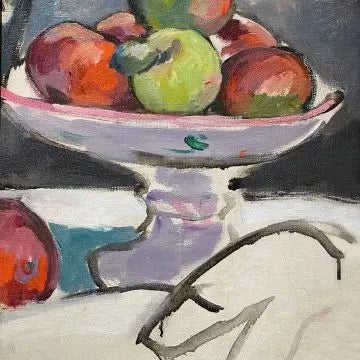

Circle of Matthew Smith
Still Life of Apples in Fruit Bowl
Oil on canvas
Image size: 13 1/2 x 11 1/2 inches (34.25 x 29 cm)
Original Giltwood frame
It is likely that this work was inspired by Matthew Smith’s work. Smith was a vehement colourist and crucial proponent of impressionist art in Britain. More specifically, this painting is comparable with Smith’s work from the 1930s or 1940s when he became freer in his application of paint in comparison to his earlier paintings. Many of Smith’s still lifes from this period are distinctive for their bold, half-block backgrounds applied with vigorous strokes of paint.
In this still life the artist’s fluid brushstrokes suggest the liveliness of the fruit while in some places the paint is so thin, so that the white ground shines through as in a watercolour. The still life is propelled into the foreground – the bowl of fruit placed on the table as if to reach out of the picture plane itself.
The sketchy style of this work suggests that the artist did not use any preliminary studies but drew his composition in thin paint, diluted with oil directly onto the blank canvas. This instinctive and direct method of painting from life has resulted in an honest and dynamic composition.
Matthew Smith
Matthew Smith was born at Halifax, in the West Riding of Yorkshire, in 1879. His family belonged to the puritanically austere and energetic industrial middle class.
He had reached his middle thirties before he began his life’s work as a painter, and even then his beginnings were tentative.
It was not until the middle 1920s that Matthew Smith evolved in all essentials both the way of seeing and the highly individual method appropriate to its expression that he has developed consistently ever since.
It is noteworthy that his first one-man exhibition at the Mayor Gallery in April 1926 was followed by the immediate recognition of his talents by a no less severe critic than Roger Fry in what was the first attempt at a considered estimate of his work.
The highly personal language of painting which he evolved in the 1920s has varied extraordinarily little. In a detailed study there would be fluctuations of style to be recorded, and periods when nudes, faces, flowers, fruit or landscapes absorbed his interest. There is also an increasing emphasis upon bold and emphatic linear rhythms.
Almost invariably he painted direct from his subject, only very rarely making use of preliminary studies. First he drew in his composition on a blank canvas in thin paint (well diluted with oil) so that it may easily be washed off.
Matthew Smith was a passionate and an instinctive painter, naturally impatient of rules and suspicious of them as tending to compromise individuality; and, as already noted, his grasp of structure fluctuates. ‘His linear drawings’, Paul Nash once observed, ‘hardly suggest the consummate painter he is.’



